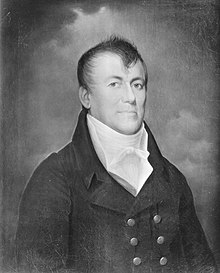Loading AI tools
American judge (1765–1830) From Wikipedia, the free encyclopedia
George Hay (December 17, 1765 – September 21, 1830) was a United States district judge of the United States District Court for the Eastern District of Virginia.
George Hay | |
|---|---|
 portrait by Cephas Thompson | |
| Judge of the United States District Court for the Eastern District of Virginia | |
| In office July 5, 1825 – September 21, 1830 | |
| Appointed by | John Quincy Adams |
| Preceded by | St. George Tucker |
| Succeeded by | Philip P. Barbour |
| Personal details | |
| Born | George Hay December 17, 1765 Williamsburg, Colony of Virginia, British America |
| Died | September 21, 1830 (aged 64) Richmond, Virginia |
| Spouse | |
| Children | 2 |
| Relatives | James Monroe (father-in-law) |
| Occupation | Judge |
Born December 17, 1765, in Williamsburg, Colony of Virginia, British America,[1] Hay read law.[1] He entered private practice in Petersburg, Virginia, from 1787 to 1801.[1] He continued private practice in Richmond from 1801 to 1803.[1] He was the United States Attorney for the District of Virginia from 1803 to 1816.[1] He was a member of the Virginia House of Delegates from 1816 to 1822.[1] He resumed private practice in Washington, D.C. from 1822 to 1825.[2][1] Hay was a close confidant to his father-in-law, James Monroe, especially during the Missouri Crisis. During the Crisis, he anonymously penned a series of pro-slavery essays for publication in the South's leading newspaper, under the title, "For the Enquirer. Missouri Question."[3]
During his service as United States Attorney, Hay served as prosecutor during the trial of Aaron Burr.[4]
Hay was an advocate for freedom of the press, and became known for his defense of James T. Callender at Callender's Sedition trial.[5]
Hay became a strong advocate of slavery and authored a series of heavily proslavery pieces during the Missouri Crisis under the penname of "An American."
Hay received a recess appointment from President John Quincy Adams on July 5, 1825, to a seat on the United States District Court for the Eastern District of Virginia vacated by Judge St. George Tucker.[1] He was nominated to the same position President Adams on December 13, 1825.[1] He was confirmed by the United States Senate on March 31, 1826, and received his commission the same day.[1] His service terminated on September 21, 1830, due to his death in Richmond.[1]
In 1808, Hay married Eliza Kortright Monroe, daughter of President James Monroe. They had one child whom reached adulthood, Hortensia. [6]
Seamless Wikipedia browsing. On steroids.
Every time you click a link to Wikipedia, Wiktionary or Wikiquote in your browser's search results, it will show the modern Wikiwand interface.
Wikiwand extension is a five stars, simple, with minimum permission required to keep your browsing private, safe and transparent.